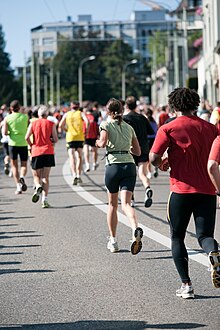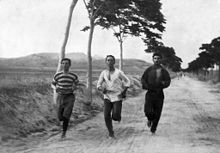
Back ركض المسافات الطويلة Arabic جرى مسافات طويله ARZ Бег на доўгія дыстанцыі Byelorussian Cursa de fons Catalan Langdistanceløb Danish Langstreckenlauf German Longdistanca kuro Esperanto Carrera de larga distancia Spanish Pikamaajooksud Estonian Distantzia luzeko lasterketa Basque



Long-distance running, or endurance running, is a form of continuous running over distances of at least 3 km (1.9 mi). Physiologically, it is largely aerobic in nature and requires stamina as well as mental strength.[2]
Within endurance running comes two different types of respiration. The more prominent side that runners experience more frequently is aerobic respiration. This occurs when oxygen is present, and the body can utilize oxygen to help generate energy and muscle activity. On the other side, anaerobic respiration occurs when the body is deprived of oxygen, and this is common towards the final stretch of races when there is a drive to speed up to a greater intensity. Overall, both types of respiration are used by endurance runners quite often but are very different from each other.
Among mammals, humans are well adapted for running significant distances, particularly so among primates. The capacity for endurance running is also found in migratory ungulates and a limited number of terrestrial carnivores, such as bears, dogs, wolves, and hyenas.
In modern human society, long-distance running has multiple purposes: people may engage in it for physical exercise, for recreation, as a means of travel, as a competitive sport, for economic reasons, or cultural reasons. Long-distance running can also be used as a means to improve cardiovascular health.[3]
Endurance running is often a component of physical military training. Long-distance running as a form of tradition or ceremony is known among the Hopi and Tarahumara people, among others.[4][5]
In the sport of athletics, long-distance events are defined as races covering 3 km (1.9 mi) and above. The three most common types are track running, road running, and cross country running, all of which are defined by their terrain – all-weather tracks, roads, and natural terrain, respectively.
- ^ Simon Burnton (18 May 2012). "50 stunning Olympic moments No31: Paavo Nurmi wins 5,000m in 1924". The Guardian. Retrieved 4 January 2023.
- ^ Lieberman, Daniel E.; Bramble, Dennis M.; Raichlen, David A.; Shea, John J. (2009), Grine, Frederick E.; Fleagle, John G.; Leakey, Richard E. (eds.), "Brains, Brawn, and the Evolution of Human Endurance Running Capabilities" (PDF), The First Humans – Origin and Early Evolution of the Genus Homo: Contributions from the Third Stony Brook Human Evolution Symposium and Workshop October 3 – October 7, 2006, Dordrecht: Springer Netherlands, pp. 77–92, doi:10.1007/978-1-4020-9980-9_8, ISBN 978-1-4020-9980-9, archived from the original on 1 November 2013, retrieved 1 November 2024
- ^ Herreman, Kari (12 September 2013). "What Are the Health Benefits of Running Half Marathons?". runnersgoal.com. Retrieved 1 March 2017.
- ^ Running in Hopi History and Culture. Hopi Cultural Preservation Office/Northern Arizona University. Retrieved 11 April 2013.
- ^ Lonergan, J. E. The ecology of servitude in Tarahumara ritual tesgüinada Archived 1 August 2013 at the Wayback Machine. International Society for Gesture Studies. Retrieved 11 April 2013.